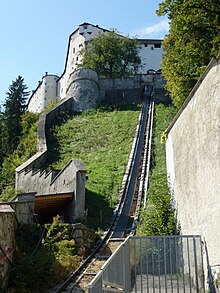History of rail transport before 1700
The History of Rail Transport includes several important events dating to the years before 1700. The earliest such event took place in 1427, well over 300 years before the first iron rails were manufactured.
Events[]

Reisszug, as it appears today
1427[]
- First known reference to the use of a hund, presumed to be a railed truck, at the Gossenass silver-lead mine (opened 1423) in the Brenner Pass, in the Holy Roman Empire (present-day Italy).[1]
1513[]
- First known dated depiction of a railed vehicle, a hund in a mine adit, shown in a window of the cathedral at Rožňava in Upper Hungary (present-day Slovakia).[2]
1515[]
- The Reisszug, a cable railway at Hohensalzburg Fortress in Salzburg, is known, believed to date from 1495 or 1504.
1571[]
- Presumed date of site with the first known rails in the British Isles, Emanuel Stolne silver mine near Caldbeck in the Lake District, worked by Austrian miners.[3]
1604[]
- October 1 - The Wollaton Wagonway, from Strelley, Nottingham to Wollaton in England, is known to have been completed by this date, being the world's first recorded overland wagonway. It ran for approximately two miles (5 km) and was built for coal haulage by Huntingdon Beaumont.[4][5][6]
1645[]
- Widow Howborne is recorded as a gatekeeper on the Whickham waggonway in County Durham, England, the first known female railway employee.
See also[]
- History of rail transport
- Years in rail transport
References[]
- ^ Lewis, M. J. T. (1970). Early Wooden Railways. London: Routledge & Kegan Paul. p. 10. ISBN 0-7100-6674-0.
- ^ Lewis, M. J. T. (1970). Early Wooden Railways. London: Routledge & Kegan Paul. p. 13. ISBN 0-7100-6674-0.
- ^ Allison, Warren; Murphy, Samuel; Smith, Richard (2010). "An early railway in the German mines of Caldbeck". In Boyes, Grahame (ed.). Early Railways 4. Sudbury: Six Martlets. pp. 52–69.
- ^ Smith, Richard S. (1960). "England's first rails: a reconsideration". Renaissance & Modern Studies. 4: 119–134.
- ^ New, John (2004). "400 years of English railways: Huntingdon Beaumont and the early years". Backtrack. 18: 660–5.
- ^ Waggonway Research Circle (August 2005). "The Wollaton Wagonway of 1604: the World's first overland railway" (PDF). Archived from the original (PDF) on 2012-02-18.
Categories:
- Rail transport timelines